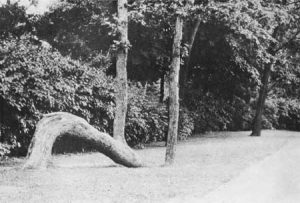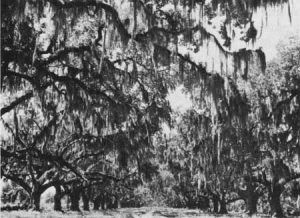IN COLONIAL DAYS 1607-1782

When the earliest settlers landed on American shores,forests covered nearly all the land from the eastern seaboard to the Great Plains. Wood was abundant and free for the taking. The colonial period was characterized by a gradual pushing back of the forests to make room for settlement. Because transportation facilities were poor,local wood shortages sometimes arose near the larger towns, and these occasionally led to restrictions on cutting. But most people felt, in the words of Gifford Pinchot, that "the thing to do with the forest was to get rid of it."

Figure 4.—Occasionally, Indian trail trees took root at their points of secondary contact with the ground. Indians bents the young saplings down to the ground to point out a trail. F—336329
1626 Plymouth Colony passed an ordinance prohibiting cutting timber on colony lands without official consent.
1681 William Penn's ordinance for the Pennsylvania colony required that, in clearing land, settlers leave 1 acre in trees for every 5 acres cleared. This provision was not long enforced.
1691 Massachusetts colony charter reserved to the King, to provide masts for the British Navy, all white pine trees 2 feet thick or more (at one foot above the ground) growing on land notpreviously granted to a private person. Later similar provisions applied from Maine to New Jersey. Violators were tried in admiralty courts.
1710 The first community forest in the United States was established at Newington, N.H. A 110-acre forest owned by the town has yielded continuing benefits to the community for more than two centuries, helping to build the village church, parsonage, town hall,and library; furnishing planks for bridges; and fuel to heat public buildings.
1728 British Navigation Acts prohibited the colonies from shipping pitch, tar, and crude gum direct to foreign countries. Measures for the regulation of the naval stores industry and for the payment of bounties were introduced by the Royal Governor of North Carolina.
1760 Another of America's earliest community forests was established at Danville, N.H. A committee was appointed to manage the town's 75-acre woodland "to keep the parson warm." Over the years the forest has yielded some $10,000 worth of products.
1777 North Carolina law prohibited unlawful firing of woods and declared that forest fires are extremely destructive to the soil.

Figure 5.—The Packenham live oaks, Louisiana. F—464570

